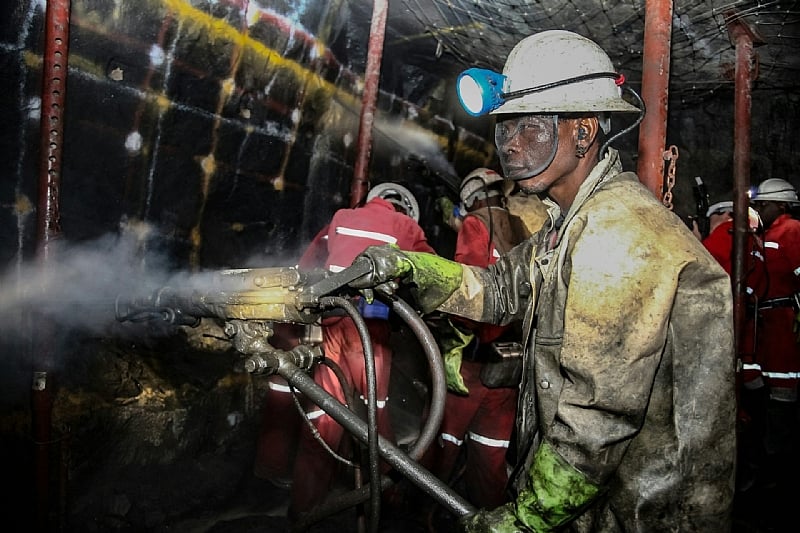DON'T MISS ANYTHING!
Subscribe to our newsletter
Lorem ipsum dolor sit amet, consectetur adipiscing elit.
Listeners:
Top listeners:
LISTEN NOW: JafriQ Radio Live On Jafriq Radio

[ad_1]
If you visit a commercial mining operation anywhere in the world today, some sights and sounds – workers descending in elevators to underground shafts, the roar of truck engines – will be much the same as they have been for decades.
But, like many other industries, mining is changing. Digital mining involves the use of digital technologies to make mining operations more efficient, safer, and sustainable. This industry emerged about a decade ago and has developed quickly over the past few years. This uptick is the result of recent advances in sensor technology, data analytics and artificial intelligence (AI), including machine learning.
However, while technology improves, old problems persist. Large-scale mining causes massive deforestation in regions like the Amazon. It also threatens and displaces communities, as in the case of Brazil’s Xikrin and Kayapó people. In the Democratic Republic of Congo (DRC), the mining of cobalt, copper and coltan (all crucial for modern technology) contaminates local water supplies and puts workers – including children – in danger.
Read more: What coltan mining in the DRC costs people and the environment
Is it time to make mining obsolete? This is not a realistic solution, at least not in the near future. Many modern technologies, like smartphones, electric vehicles, solar panels and wind turbines, depend on minerals extracted through mining. The global move towards renewable energy and low-carbon technologies means demand for minerals like lithium and cobalt is rising.
So, while mining has environmental costs, it’s also critical in the shift to a greener economy. And mining is economically important in many parts of the world. In African countries it supports millions of jobs and contributes significantly to GDP.
This is why sustainable mining is crucial. I am a professor of information systems. I investigate the complex interactions between technology, people and organisations in achieving sustainability goals. In a recent paper with a co-author, I examined how digital technologies could help mining operations to balance economic objectives with environmental and social sustainability.
The findings make it clear that digital technologies can transform mining practices and achieve sustainability goals at the same time.
Economic outcomes
Our paper took the form of a case study. We interviewed professionals from a leading digital mining solutions company. It has operations in South Africa, Australia, Brazil, Chile and the United States. The interviewees were engineers, senior managers and executives. They offered a glimpse into how their large-scale mining clients were using digital technologies like automated haul trucks and collision avoidance systems.
We wanted to know how their clients saw the role of digital technology in balancing business and other goals. They outlined some successful cases and others where companies were struggling to align all their aims.
It was clear that the company and its clients recognised the importance of safety and environmental issues in their work. But they saw these issues through the lens of business sustainability. For instance, while some mining companies pursued safety improvements, they did it primarily to boost productivity and bring down costs.
One interviewee gave the example of collision avoidance systems. Companies valued these because they reduced downtime and improved productivity. They focused on immediate business needs.
A balancing act
It’s time for mining companies that are serious about sustainability to shift their focus. Rather than simply looking to make immediate profits, they need to consider environmental and social impacts – and the role digital technology can play.
As a simple example, AI can predict when machinery is likely to fail. This allows companies to carry out timely maintenance. Equipment lifespan is extended. Downtime and repair costs are reduced. And worker safety is improved because there are fewer unexpected breakdowns. This is the kind of sustainable approach, underpinned by digital technology, that can help mining companies tick all the right boxes.
Mining leaders must not exclude employees and stakeholders when considering these issues. Environmental advocates have a role to play, too: companies must work with these groups and with local communities. A shared understanding of how digital technologies can meet both financial and sustainability targets is key.
Mining companies are more likely to change if there are clear financial benefits or penalties tied to sustainability. Governments can help by introducing stricter environmental regulations and offering incentives to adopt sustainable digital technologies. In South Africa, for instance, there are tax incentives and subsidies to encourage the use of renewable energy in mining. These measures, expanded recently in response to the country’s energy crisis, have sparked significant investment in solar power.

Get the latest in African news delivered straight to your inbox
Almost finished…
We need to confirm your email address.
To complete the process, please follow the instructions in the email we just sent you.
There was a problem processing your submission. Please try again later.
When paired with digital monitoring systems, renewable energy solutions can enhance efficiency by optimising energy consumption and reducing carbon emissions. Technologies like AI-driven energy management systems can help mines integrate renewable sources with less energy wastage. Thus, tax breaks or subsidies for digital solutions that support green energy adoption could motivate companies to embrace greener and more tech-driven mining practices.
Consumers and investors, meanwhile, should invest in those mining companies that demonstrate responsible practices. Ethical investment funds need to support companies with strong environmental, social, and governance credentials.
Rennie Naidoo, Professor of Information Systems, University of the Witwatersrand
[ad_2]
Written by: jafriqradio
africa Business Business and Finance Central Africa Climate Congo-Kinshasa current events economy Environment Innovation Mining news Politics sports trade travel

For every Show page the timetable is auomatically generated from the schedule, and you can set automatic carousels of Podcasts, Articles and Charts by simply choosing a category. Curabitur id lacus felis. Sed justo mauris, auctor eget tellus nec, pellentesque varius mauris. Sed eu congue nulla, et tincidunt justo. Aliquam semper faucibus odio id varius. Suspendisse varius laoreet sodales.
closeLorem ipsum dolor sit amet, consectetur adipiscing elit.
© JAfriq RAdio 2024 All Rights Reserved. By Octagram, Inc
Post comments (0)